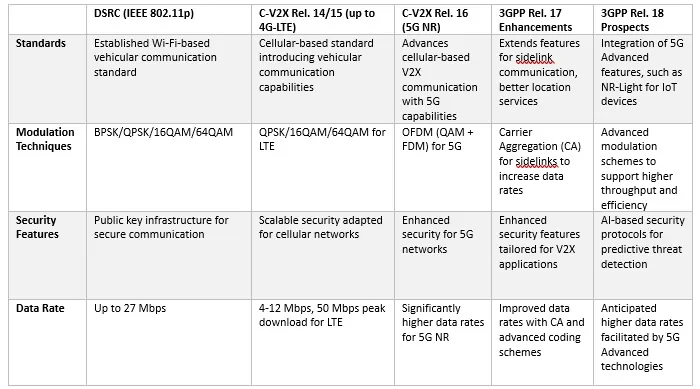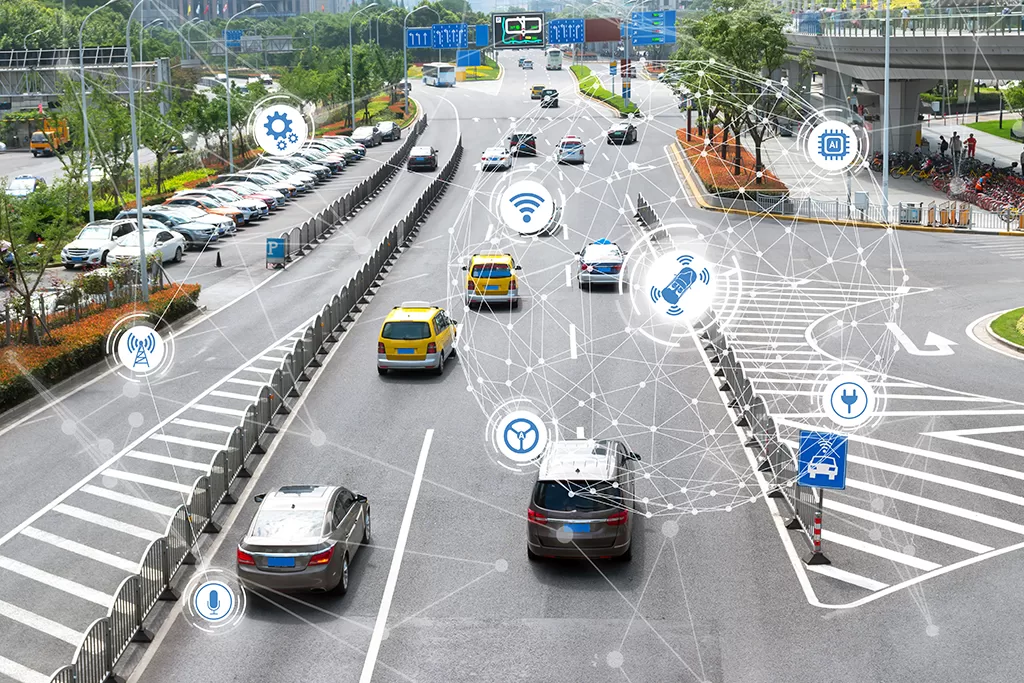Introduction
This rapid development of 3GPP standards remains at the heart of all advancements taking place for 5G technologies and applies to the set of standards development for not only conventional telecommunications but increasingly for the critical area of Vehicle-to-Everything (V2X) communication, mainly leveraged by the Internet of Things (IoT), which is flourishing.
Release 17 heralds a leap in 5G capabilities, spearheaded in the advancements of Sidelink technologies to support not only vehicle-to-vehicle (V2V) and vehicle-to-infrastructure (V2I) communication sets but further into the IoT, where such a connection enters this enormous network. These developments help mold the shaping of a sophisticated, IoT-facilitated traffic ecosystem empowered by an unending flow of data not only from vehicles but also from the infrastructure and an entire myriad of IoT devices.
Joining into a symphony of intelligent interactions that makes them achieve efficiency and safety. Indeed, with this evolution toward further development of 3GPP Release 18, promises of augmented enhancements may call to a future where V2X communications are closer with the IoT framework. Preliminary insights point toward a release that should refine not only its existing functionalities but also bring new capabilities set to revolutionize the IoT and V2X synergy.
These may include the possibility of improved data rates, improved spectrum efficiency, and solid integration of artificial intelligence, technologies paramount to predictive and managed approaches of transportation dynamics within the IoT paradigm.
This article aims to provide a forward-looking perspective on the current and upcoming innovations in 3GPP V2X standards and their potential to shape a connected future, where the convergence of vehicles, devices, and infrastructure creates an interconnected ecosystem that is smart, responsive, and increasingly autonomous.
Evolution of IoT and Sidelink Capabilities
Sidelink communication represents a significant leap forward in direct device-to-device communication protocols. Originating from its initial conceptualization and subsequent introduction in 3GPP Release 14, Sidelink technology has continually evolved to meet the demanding requirements of modern telecommunications networks, especially in the context of V2X communications.

Release 17 Enhancements
The enhancements introduced in 3GPP Release 17, particularly the advanced Sidelink technologies, lay the groundwork for vehicles to seamlessly integrate into the IoT. These technological improvements enable vehicles to communicate more effectively, not only with each other (V2V) and infrastructure (V2I) but also with a multitude of IoT devices. This creates a mesh of connectivity that can transmit critical data, respond to environmental changes, and enhance the functionality of smart cities.
For instance, vehicles can exchange information with traffic lights and road sensors, adjusting their routes in real-time to optimize traffic flow and reduce congestion. Furthermore, Release 17 facilitates the integration of vehicles into IoT ecosystems by providing the means for direct communication with smart city infrastructure and personal IoT devices. This enables a plethora of new applications such as environmental monitoring through sensors deployed across urban areas, and automated parking solutions that communicate directly with vehicles.
As vehicles become increasingly autonomous, the role of Sidelink communication in the IoT realm is set to expand. Cars could act as mobile data centers, processing and relaying information from a network of devices and sensors distributed throughout urban and rural environments. This enhanced communication capability is essential for supporting modern IoT-driven transportation systems, where data from various sources needs to be synthesized and acted upon in near real-time.
Additionally, Release 17 extended the operation of Sidelinks into unlicensed spectrum bands. This expansion into the unlicensed spectrum is a strategic move to accommodate the growing demand for bandwidth in densely populated urban environments, where V2X communications must coexist with a plethora of other wireless devices without causing detrimental interference.
Release 17 also focused on enhancing the efficiency and scope of Proximity Services (ProSe), which are essential for enabling devices in close physical proximity to communicate directly without relying on network infrastructure. This improvement is particularly relevant in scenarios where network coverage is patchy or non-existent, such as remote rural areas or densely built urban centers.
Anticipated Innovations in Release 18
Moving forward, 3GPP Release 18 aims to build upon these foundational improvements with several anticipated innovations. These enhancements are expected to address some of the limitations still present in Sidelink communication technologies.
Firstly, there is a strong focus on further increasing the data rates for Sidelink communications. With the advent of 5G Advanced, the potential for ultra-high-speed data transmission between devices opens up new avenues for applications that were previously constrained by bandwidth limitations. Applications such as high-definition map updates for autonomous vehicles, real-time video streaming from vehicle dashcams, and more complex sensor sharing protocols stand to gain substantially from these improvements.
Moreover, Release 18 is likely to introduce more refined mechanisms for spectrum sharing between V2X and other types of communication. This includes improved dynamic spectrum access technologies that allow V2X communications to utilize available spectrum bands more efficiently, particularly in environments where spectrum resources are scarce.
Additionally, the integration of artificial intelligence and machine learning into Sidelink management protocols is being explored. These technologies could potentially automate the optimization of communication channels and power levels, greatly enhancing the adaptability and efficiency of Sidelink communications in changing environmental conditions and traffic scenarios.
Enhancements in V2X Communication Standards
As the landscape of intelligent transportation systems continues to evolve, V2X communication standards emerge as the backbone of this transformation, aimed at creating a network of seamless and automated interactions.
The ongoing development of 3GPP standards, particularly Releases 17 and 18, is at the forefront of this revolution, promising to integrate traditional vehicular communication technologies like DSRC and C-V2X into a unified system that could redefine transportation.
Table 1:Evolution and Enhancements in Standards

Release 17 has introduced significant advancements in beamforming techniques, addressing one of the fundamental challenges within both DSRC and C-V2X domains—the efficient use of spectrum. By directing radio wave broadcasts towards specific receivers, Release 17’s beamforming capabilities improve signal quality and reduce interference, a crucial advancement for high-density scenarios common in urban environments. This is particularly relevant for DSRC technologies, which operate within a limited spectrum range.
Further, Release 17 has refined modulation and coding schemes, optimizing data transmission rates and connection robustness.
Looking ahead to Release 18, a key focus is the incorporation of artificial intelligence (AI) into traffic management systems. These systems, leveraging AI and machine learning, are anticipated to dissect and interpret traffic patterns and vehicle data with unprecedented precision. For C-V2X, which thrives on cellular networks’ expansive coverage and connectivity, the integration of AI could lead to optimized route planning and traffic flow, alleviating congestion and reducing travel times in smart cities.
Moreover, Release 18 is poised to further enhance the latency and reliability of V2X communications by introducing URLLC features.
This evolution is critical for safety applications that both DSRC and C-V2X technologies aim to bolster. URLLC will be particularly transformative for C-V2X, as it supports direct communication modes essential for collision avoidance and emergency responses.
The convergence of DSRC and C-V2X within the framework of the latest 3GPP releases represents a strategic merger of complementary technologies. DSRC, with its dedicated spectrum and rapid communication protocol, and C-V2X, with its superior range and reliability, are being enhanced by 3GPP’s rigorous standardization processes to meet the diverse requirements of future vehicular networks.
Technical Challenges and Solutions
The transition from 3GPP Release 17 to Release 18 not only heralds a suite of enhancements in IoT and V2X communications but also brings to the fore several technical challenges.
Addressing these is imperative to ensure the seamless operation and full potential of these emerging technologies.
Scalability and Network Congestion
As the IoT and V2X landscape grows, the proliferation of connected vehicles and devices puts an immense strain on network resources. This growing demand risks network congestion, particularly in densely populated urban centers, threatening the integrity of critical safety communications. In response, advanced network slicing is set to be a key feature of Release 18, creating virtually independent networks within a single physical network to uphold the high reliability and low latency required for essential V2X communications. Additionally, the introduction of dynamic spectrum management aims to judiciously allocate spectrum resources, optimizing bandwidth, and alleviating network strain.
Security Vulnerabilities in IoT
The interconnected nature of IoT brings forth unique security challenges, where a breach in one node could potentially compromise the entire network.
The robust framework of encryption and authentication protocols that Release 18 is expected to bring will have to be designed with IoT’s vast and varied devices in mind. It’s not just about safeguarding communication between vehicles anymore; it’s about ensuring the integrity of data flowing across a multitude of IoT devices that interact with these vehicles.
This could involve implementing more granular security policies, tailored to the different types of devices within the IoT ecosystem.
IoT Latency and Reliability
Ultra-reliable and low-latency communication (URLLC) is at the heart of V2X, particularly for safety-critical applications. The dynamic urban environment poses a significant challenge to achieving consistently low latency and unwavering reliability. With an eye towards URLLC, Release 18 aims to refine protocols and network infrastructures, potentially employing edge computing to bring data processing closer to the data source, thereby trimming response times. Predictive network algorithms that utilize artificial intelligence will further aid in managing network loads proactively, ensuring service quality even during peak demands.
Interoperability Among Diverse IoT Standards
Lastly, the varying devices and technologies that make up the IoT and V2X ecosystems can lead to interoperability issues, disrupting the fluid exchange of information. The solution lies in the standardization of communication protocols and in nurturing collaborative efforts across the industry. With a concerted push towards unified standards and protocols, Release 18 underscores the need for compatibility and seamless integration across the diverse technological spectrum.
In sum, the journey from Release 17 to Release 18 is not without its challenges. Yet, with strategic solutions in sight, the path forward looks promising for the realization of a fully integrated, secure, and efficient V2X communication system.
Conclusion
In conclusion, it’s clear that the progression of 3GPP standards from Release 17 to Release 18 marks a significant advancement in V2X communication technologies.
From the D2D communication point of view, Release 17 has set a very strong baseline with the enhanced Sidelink capabilities and enhanced spectrum usage, thus suiting the innovative and stringent needs of IoT-driven transportation systems.
Moving on to Release 18, not only will some of these be polished up as promised, but there might be seen as a significant overhaul, with traffic management systems integrating AI for URLLC features to go live.
These improvements bear the promise of even better data rates, spectrum efficiency, and reliability—areas of high need in support of the next-generation intelligent transport systems.
How these technological evolutions play out, the harmonization of DSRC with C-V2X under 3GPP standardization seems like the most plausible possibility driving the world’s vision in vehicular communications.
References
- Kiela, M. Jurgo and R. Navickas, “Structure of V2X-IoT framework for ITS applications,” 2020 43rd International Conference on Telecommunications and Signal Processing (TSP), Milan, Italy, 2020, pp. 229-234, doi: 10.1109/TSP49548.2020.9163539.
- 3GPP TR 22.886, ”Study on enhancement of 3GPP Support for 5G V2X Services”, v15.1.0, Mar. 2017
- Xingqin Lin, “An Overview of 5G Advanced Evolution in 3GPP Release 18”, IEEE Communications Standards Magazine

